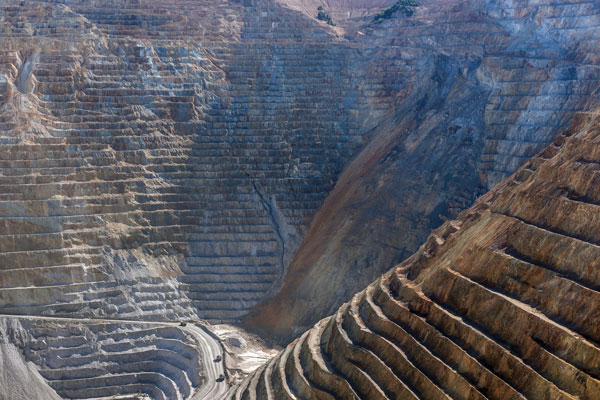A look around the scenic state of Utah provides a glimpse at a diverse landscape of snow-topped mountains, canyons uniquely carved by time and sprawling salt flats. While these sights draw our eyes up, rich mineral deposits that lie beneath keep drawing miners in.
The industry has deep roots in the state, which has been a hotspot for fossil fuels and rich mineral deposits of copper, gold and silver. These are just a few examples of the natural resources Utah has to offer.
“Early miners have found success in coal mining in central Utah, copper in the southwest side of the Salt Lake Valley, and oil and oil shale in the northeast,” says Utah Governor’s Office Of Economic Opportunity Managing Director of Incentives & Grants Jim Grover. “We also found great potential for geothermal energy in central and southwest Utah and are closely following the discoveries of lithium, which can be potentially valuable resources within our state.”
Currently, Utah ranks as the No.7 U.S. state for mineral production, valued at $3.6 billion in 2023. The 2022 Fraser Institute Annual Survey of Mining Companies, released in May 2023, showed Utah earned the No. 2 rank in terms of the Policy Perception Index. Out of 62 jurisdictions, the state solidified its place based on attractive mining policies for factors such as environmental regulations, trade barriers, taxation regime and infrastructure.
Moving forward, Utah is well positioned to enhance its mineral production and rise higher among the top 10 U.S. mining states. Within the last year, the state has secured three mining projects that will bring in a combined total of $189 million of investment in three distinct regions of the state.
Back in Beaver County
When Milford Mining Company’s Utah Vice President Darin Malchus announced a $20 million expansion of its operations in western Utah’s Beaver County in February 2024, he said that the county has historically been known as a location for high-grade minerals.
“Never before has copper been so important to the nation’s energy systems as it is currently,” said Malchus. “Utah’s cooperation with the mining community, combined with access to local talent, were significant factors in Milford Mining’s decision to commence operations in the state.”
Located in Milford, the company specializes in copper ore mining. The expansion will bring a flotation mill and a solvent extraction-electrowinning process, which will allow the company to produce copper concentrate and pure copper cathode. Once complete, the project will create 160 new jobs.
By introducing this new technology, Milford Mining will enhance operation efficiency and safety, while reducing its environmental footprint in the state. Grover says the company was approved for a five-year, 50% reduction of new-state revenue of up to $754,865, conditional upon post-performance job creation. The state legislature explains that the REDTIF tax credit is a post-performance, refundable tax credit rebate for up to 50% of new state revenues (sales, corporate, and withholding taxes paid to the state) over the life of a project (typically five to 10 years).
“Companies need to reduce financial risks when it comes to any opening or reopening of a mine in Utah,” says Grover. “With Utah’s rich history in mining comes expertise to assist companies in their success.”
Awakening The Dormant
That expertise proved vital in securing a $150 million investment from Canada-based mining company Osisko Development Corporation’s subsidiary Tintic Consolidated Metals. The 17,000-acre project is located in rural Utah’s Juab County about 60 miles south of Salt Lake City. Here the company will bring new life to a dormant mine.
The Tintic Project will be housed in the historic East Tintic Mining District targeting porphyry, carbonate and epithermal minerals used for gold mineralization. Over the next five years Tintic Consolidated Metals will create 150 new jobs in the region, resulting in over $70 million in wages.
“Utah approved a five-year, 50% temporary reduction in new-state revenue of up to $9.6 million to Tintic Consolidated Metals conditional upon post-performance job creation,” says Grover.
Like Milford Mining’s project, the awarded funding comes from Utah’s Rural Economic Development Tax Increment Financing program. For Tintic, this funding gave a much needed push to get this project off the ground.
“Since acquiring Tintic in May last year, we have been continually impressed with the strong support that the state of Utah has shown for mining companies,” said Osisko Development CEO Sean Roosen. “Utah has established itself as a world-class jurisdiction by creating an efficient, transparent, predictable, and informed mining regime that is highly favorable for exploration, development and operation. It is also home to a deep pool of mining talent,” he said, including professional miners, drillers, engineers, lawyers and accountants. “It is no wonder why the state consistently ranks in the top five places to mine globally.”
This location is expected to aid the company in fast-tracking Trixie, one of several gold and base metal targets. A March 2024 mineral resource update released by the company shows that there are 245,000 tons of measured or indicated gold and silver deposits measured in the mine.
“These high-grade gold targets, combined with the copper-gold porphyry potential where drilling is underway and a large area of polymetallic carbonate replacement potential, illustrate that we have only scratched the surface in understanding the overall metal endowment potential of the Tintic district,” said Osisko Development President Chris Lodder.
Meeting a National Need
Project Fluorescent, announced by Ares Strategic Mining in June 2023, marks an initial effort to increase domestic production of fluorspar. Six years ago, the U.S. government classified fluorspar as a critical mineral for its impact on national security and the economy. This mineral is a key product used by the U.S. Department of Defense, although it represents the only non-metallic critical mineral for which the U.S. depends on importing.
Ares Strategic Mining has plans to change that from the only permitted fluorspar mine in the U.S., located inside the Lost Sheep Mine in Delta, Utah. The Canada-based company is known globally for its exploration and production of metallurgical and acidspar grades of fluorspar, which is used in the steel, aluminum and chemical industries.
As of March 2024, the company announced that it had completed its mine planning phase and would now begin construction of the $19 million project. Ramp installation is said to be the first step in construction activity. During the planning phase, diamond drilling results allowed the company to identify the best location to install a ramp portal in the mine. In addition, drilling revealed fluorspar mineralization at depths of 278 feet, a welcome surprise for the team. Overall, 40 new jobs will be created once fully operational.
“Seeing the project get closer to production is extremely encouraging and motivating,” said Ares Strategic Mining President and CEO James Walker in the announcement. “The visually confirmed fluorspar mineralization from the current drill program was an unexpected bonus and provided us with further confidence in our upcoming operation. The ramp currently under construction is the biggest development towards the largest fluorspar operation ever seen at the Spor Mountain Range, which has almost 100 years of mining history.”
Utah’s growing aerospace and defense sector makes up close to 20% of the state’s GDP, making a local supply chain of fluorspar highly beneficial. Industry leaders Boeing, Lockheed Martin and Northrop Grumman are among companies in the state that can access this resource, if needed, with ease.
“With the increasing demand for onshore manufacturing, Utah is well-positioned with abundant resources and a demonstrated commitment to creating opportunities and fostering partnerships with businesses seeking natural resources, thereby solidifying its role as a key player in the global mining industry over the next 10 years,” says Grover.

